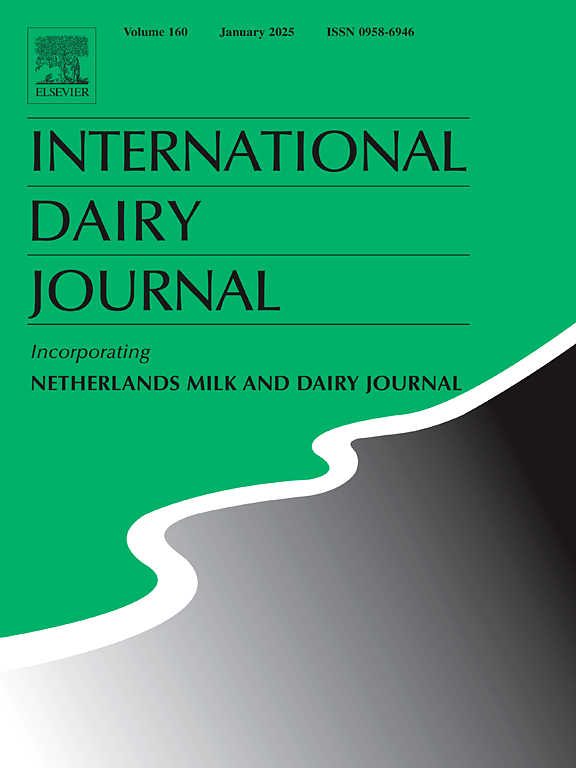羊奶蛋白中新型ACE抑制肽的探索及其分子机制:硅和体外联合研究
IF 3.1
3区 农林科学
Q2 FOOD SCIENCE & TECHNOLOGY
引用次数: 0
摘要
高血压对人类健康构成重大威胁,有效探索食源性血管紧张素i转换酶抑制(ACEI)肽作为更温和、更安全的ACEI药物替代品已引起越来越多的关注。因此,我们进行了硅和体外联合研究,从羊奶蛋白中提取新的ACEI肽。首先,木瓜蛋白酶+蛋白酶K被确定为使用BIOPEP生成ACEI肽的最佳酶组合。进一步优化木瓜蛋白酶/蛋白酶的酶促条件、酶的输入顺序、酶解产物分子量(MW),以获得ACEI活性最高的酶解产物。在优化条件下,从山羊乳水解物(MW <;3 KDa)。其中,6个潜在的ACEI新肽被虚拟有效筛选。使用合成肽进行的验证研究部分证实了计算机结果,6个选定肽中有4个(FKF、FRY、RWL和WKP)显示出ACEI活性。此外,在自发性高血压大鼠(SHRs)中进一步验证了前两种ACEI肽(FRY和FKF)的降血压作用,FRY治疗显著降低了shs的血压。综上所述,本研究建立了一种快速筛选新型ACEI肽的酶解体系,并鉴定出一种新型抗高血压肽FRY,为羊奶生物活性肽的研究和高价值利用提供了新的研究方法。本文章由计算机程序翻译,如有差异,请以英文原文为准。
Exploration and molecular mechanism of novel ACE inhibitory peptides from goat milk protein: A combined in silico and in vitro study
Hypertension poses a significant threat to human health, and the efficient exploration of food-derived angiotensin I-converting enzyme inhibitory (ACEI) peptides as milder and safer alternatives to ACEI drugs has garnered increasing attention. Therefore, a combined in silico and in vitro study was performed to investigate novel ACEI peptides from goat milk proteins. First, the papain plus proteinase K was identified as the best enzymatic combination for generating ACEI peptides using BIOPEP. Then the enzymatic conditions of the papain/proteinase, the input order of the enzymes, and the molecular weight (MW) of the hydrolysate were further optimized to obtain the hydrolysate with the highest ACEI activity. Under the optimized condition described, 698 peptides (<25 A A) were successfully identified from the milk hydrolysate of goat (MW < 3 KDa). Among them, six potential novel ACEI peptides were efficiently screened virtually. Verification studies using synthesized peptides partially confirmed the in silico results, with four out of the six selected peptides (FKF, FRY, RWL, and WKP) exhibiting ACEI activity. Additionally, the blood pressure-lowering effects of the top two ACEI peptides (FRY and FKF) were further validated in spontaneously hypertensive rats (SHRs), and FRY treatment significantly lowered the blood pressure of SHRs. To summarize, this study established a rapid enzymatic hydrolysis system for screening novel ACEI peptides and identified a novel antihypertensive peptide, FRY, which provides a new method for research on bioactive peptides research and high-value utilization of goat milk.
求助全文
通过发布文献求助,成功后即可免费获取论文全文。
去求助
来源期刊

International Dairy Journal
工程技术-食品科技
CiteScore
6.50
自引率
9.70%
发文量
200
审稿时长
49 days
期刊介绍:
The International Dairy Journal publishes significant advancements in dairy science and technology in the form of research articles and critical reviews that are of relevance to the broader international dairy community. Within this scope, research on the science and technology of milk and dairy products and the nutritional and health aspects of dairy foods are included; the journal pays particular attention to applied research and its interface with the dairy industry.
The journal''s coverage includes the following, where directly applicable to dairy science and technology:
• Chemistry and physico-chemical properties of milk constituents
• Microbiology, food safety, enzymology, biotechnology
• Processing and engineering
• Emulsion science, food structure, and texture
• Raw material quality and effect on relevant products
• Flavour and off-flavour development
• Technological functionality and applications of dairy ingredients
• Sensory and consumer sciences
• Nutrition and substantiation of human health implications of milk components or dairy products
International Dairy Journal does not publish papers related to milk production, animal health and other aspects of on-farm milk production unless there is a clear relationship to dairy technology, human health or final product quality.
 求助内容:
求助内容: 应助结果提醒方式:
应助结果提醒方式:


